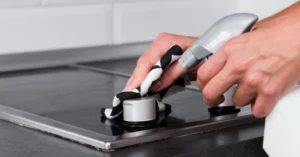Nothing’s more frustrating than opening your dishwasher to find plates still caked with food or glasses covered in a gritty film. If your dishwasher isn’t cleaning dishes like it used to, don’t rush to replace it—or resign yourself to hand-washing. Most issues have simple, DIY fixes that can restore your appliance’s sparkle in no time. In this guide, we’ll uncover the top five reasons your dishwasher isn’t performing and provide step-by-step solutions to get your dishes spotless again. Plus, we’ll share expert maintenance tips, answer common questions, and tell you when it’s time to call in a pro.
Why Is My Dishwasher Leaving Dishes Dirty?
Dishwashers rely on a combination of hot water, detergent, and mechanical action to clean dishes. When one of these elements fails, you’re left with disappointing results. Common culprits include clogged components, improper loading, or inadequate water conditions. Let’s dive into the top five reasons your dishwasher isn’t cleaning and how to fix them.
1. Clogged Spray Arms Are Blocking Water Flow
The Problem
Spray arms are the spinning components that shoot water onto your dishes. Over time, food particles, mineral deposits from hard water, or even small seeds (like tomato or raspberry seeds) can clog the tiny holes (jets) in these arms, reducing water pressure and leaving dishes dirty.
The Fix
- Step 1: Unplug the dishwasher or turn off the power at the circuit breaker for safety.
- Step 2: Remove the spray arms. Most models have a lower and upper arm that snap off or unscrew (check your manual for specifics).
- Step 3: Inspect the jets for debris. Use a toothpick, straightened paper clip, or small brush to clear clogs.
- Step 4: Soak the arms in a 1:1 mixture of white vinegar and warm water for 15–20 minutes to dissolve mineral buildup.
- Step 5: Rinse thoroughly, reinstall, and run an empty cycle to flush out any remaining debris.
Pro Tip
Clean spray arms every 2–3 months, especially if you have hard water, to maintain optimal performance.
2. A Dirty Filter Is Recirculating Grime
The Problem
Your dishwasher’s filter traps food particles to prevent them from redepositing on dishes. If it’s clogged with grease or debris, dirty water circulates during the wash cycle, leaving a gritty residue on your plates and glasses.
The Fix
- Step 1: Locate the filter, usually at the bottom of the dishwasher tub. Some models have removable filters, while older ones (pre-2010) may have self-cleaning filters.
- Step 2: Remove the filter (twist or pull, per your manual) and rinse it under warm water.
- Step 3: For stubborn gunk, soak the filter in soapy water or vinegar for 10 minutes, then scrub gently with a soft brush.
- Step 4: Reinstall the filter and run a hot cycle with a dishwasher cleaner like Affresh or Finish to freshen the interior.
Pro Tip
Clean the filter monthly to prevent odors and ensure clean dishes. If your filter is damaged, replace it to avoid leaks or poor performance.
3. Improper Loading Is Blocking Water Spray
The Problem
Overloading or incorrectly arranging dishes can block the spray arms, preventing water and detergent from reaching all surfaces. Nesting dishes, stacking bowls, or placing large items incorrectly often leads to greasy or spotty results.
The Fix
- Step 1: Arrange dishes to face the center of the dishwasher at a downward angle. Avoid overlapping plates or nesting bowls.
- Step 2: Place larger items (pots, pans) on the bottom rack, ensuring they don’t obstruct spray arms.
- Step 3: Load glasses, cups, and small items on the top rack to prevent the dishwasher from missing spots.
- Step 4: Secure small items like lids in the utensil basket to avoid them falling and blocking the arms.
- Step 5: Run a test cycle and check if dishes come out cleaner.
Pro Tip
Scrape off excess food but avoid pre-rinsing too thoroughly—modern dishwashers use sensors to detect soil levels and adjust cycles. Over-rinsing can trick the sensor into running a shorter, less effective cycle.
4. Incorrect Detergent or Rinse Aid Usage
The Problem
Using the wrong detergent, too much detergent, or skipping rinse aid can lead to residue, streaks, or cloudy glassware. Hard water exacerbates these issues by leaving mineral deposits. Additionally, a faulty detergent dispenser may not release soap properly, reducing cleaning power.
The Fix
- Step 1: Use only automatic dishwasher detergent (tablets, pods, or powder). Avoid regular dish soap, which creates excessive suds and can damage the machine.
- Step 2: Follow the manufacturer’s detergent dosage guidelines. For soft water, use less; for hard water, slightly more.
- Step 3: Top up the rinse aid dispenser to reduce spots and improve drying. Brands like Finish or Cascade Rinse Aid work well.
- Step 4: Check the detergent dispenser for clogs or a jammed spring. Clean it with a toothbrush and hot water-vinegar mix.
- Step 5: If the dispenser is broken, replace it or consult a professional.
Pro Tip
Store detergent in a cool, dry place to prevent clumping, which can reduce effectiveness. If you have hard water, consider using a water softener or adding dishwasher salt to combat limescale.
5. Low Water Temperature or Supply Issues
The Problem
Dishwashers need water at 120°F (49°C) to dissolve detergent and remove grease. If your water heater is set too low or the inlet valve is faulty, the dishwasher may not fill properly, resulting in poor cleaning. A clogged inlet valve screen can also restrict water flow.
The Fix
- Step 1: Check your water heater and ensure it’s set to 120°F. Avoid setting it higher to prevent scalding.
- Step 2: Run the kitchen faucet on hot for 30–60 seconds before starting the dishwasher to ensure hot water enters the machine.
- Step 3: Inspect the inlet valve (usually behind the lower access panel). Unplug the dishwasher, shut off the water supply, and remove the valve to clean the screen.
- Step 4: If the valve is faulty (e.g., you hear a hammering sound), replace it or call a technician.
- Step 5: Place an empty cup on both racks and run a cycle. If the cups fill with water, your dishwasher is getting enough water.
Pro Tip
Low water pressure in your home can also affect performance. If faucets show reduced pressure, consult a plumber to address the issue.
Bonus Maintenance Tips for a Spotless Dishwasher
To keep your dishwasher running like new, adopt these habits:
- Run a Monthly Vinegar Cycle: Place 2–3 cups of white vinegar in a dishwasher-safe bowl on the bottom rack and run a hot cycle to remove grease and limescale.
- Check the Drain: Clear debris from the drain basket to prevent pooling water, which can cause odors and redeposit grime.
- Use Dishwasher Cleaner: Products like Cascade Platinum or Affresh remove buildup and keep the interior fresh.
- Inspect the Door Gasket: Wipe it down regularly to prevent mold and ensure a tight seal.
When to Call a Professional
While most dishwasher issues have DIY fixes, some problems require expert intervention. Contact a professional if:
- The inlet valve or circulation pump is faulty, as these repairs involve complex wiring or plumbing.
- The dishwasher displays error codes or fails to start, indicating a potential control board issue.
- You notice persistent leaks, which could stem from a damaged tub or worn door gasket.
- The motor or chopper blade is malfunctioning, requiring specialized tools to replace.
- You’ve tried all fixes, but dishes still come out dirty, suggesting a deeper mechanical issue.
For reliable service, visit our dishwasher repair page to schedule an appointment with our certified technicians. They’ll diagnose the problem and get your dishwasher back to peak performance in no time.
Frequently Asked Questions (FAQs)
1. How do I clean a clogged spray arm in my dishwasher?
Remove the spray arms, clear debris from the jets using a toothpick or paper clip, and soak them in a vinegar-water solution for 15 minutes. Rinse and reinstall.
2. Why are my dishes still greasy after a dishwasher cycle?
Greasy dishes may result from low water temperature, a clogged filter, or insufficient detergent. Ensure water is 120°F, clean the filter, and use a high-quality detergent with rinse aid.
3. How do I clean my dishwasher filter?
Locate the filter at the bottom of the tub, remove it, and rinse under warm water. Soak in soapy water or vinegar for tough grime, then scrub gently and reinstall.
4. What does rinse aid do in a dishwasher?
Rinse aid reduces water spots and improves drying by helping water sheet off dishes. It’s especially useful in hard water areas to prevent mineral buildup.
5. Why is my dishwasher leaving residue on dishes?
Residue can stem from a clogged filter, improper detergent use, or hard water. Clean the filter, use the correct detergent amount, and add rinse aid or dishwasher salt.
6. How can I make my dishwasher dry better?
Top up rinse aid, select a heated dry cycle, and open the door slightly after the cycle to release steam. Ensure the heating element is working if your model has one.
7. Why does my dishwasher smell bad?
Odors are often caused by trapped food in the filter or drain. Clean these components regularly and run a vinegar cycle or use a dishwasher cleaner monthly.
8. How do I deep clean my dishwasher?
Run an empty hot cycle with 2 cups of white vinegar in a bowl on the bottom rack. Follow with a cycle using a dishwasher cleaner to remove grease and limescale.
9. Can a dishwasher remove oil?
Yes, dishwashers can remove oil if water is hot enough (120°F) and you use a quality detergent. Scrape off excess oil before loading to avoid clogging the filter.
10. How do I reset my dishwasher?
Unplug the dishwasher or turn off the circuit breaker for 1–2 minutes, then restore power. Check your manual for model-specific reset instructions.
Conclusion: Get Your Dishwasher Back to Sparkling Clean
A dishwasher that isn’t cleaning dishes can turn a convenient appliance into a source of frustration. By addressing clogged spray arms, dirty filters, improper loading, detergent issues, and water supply problems, you can restore your dishwasher’s performance without breaking the bank. Regular maintenance, like cleaning filters and running vinegar cycles, will keep your dishes spotless and your appliance running smoothly for years.
If you’ve tried these fixes and still face issues, don’t hesitate to call a professional. A certified technician can diagnose complex problems and save you time and hassle. Ready to get your dishwasher back in top shape? Schedule a repair today and enjoy sparkling clean dishes again!






